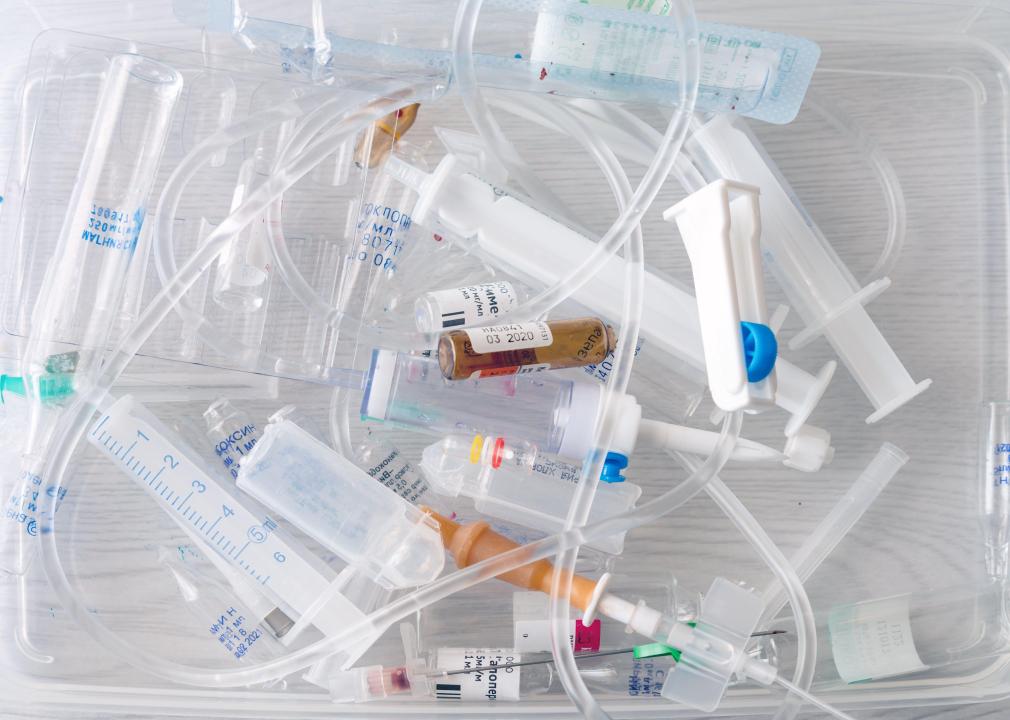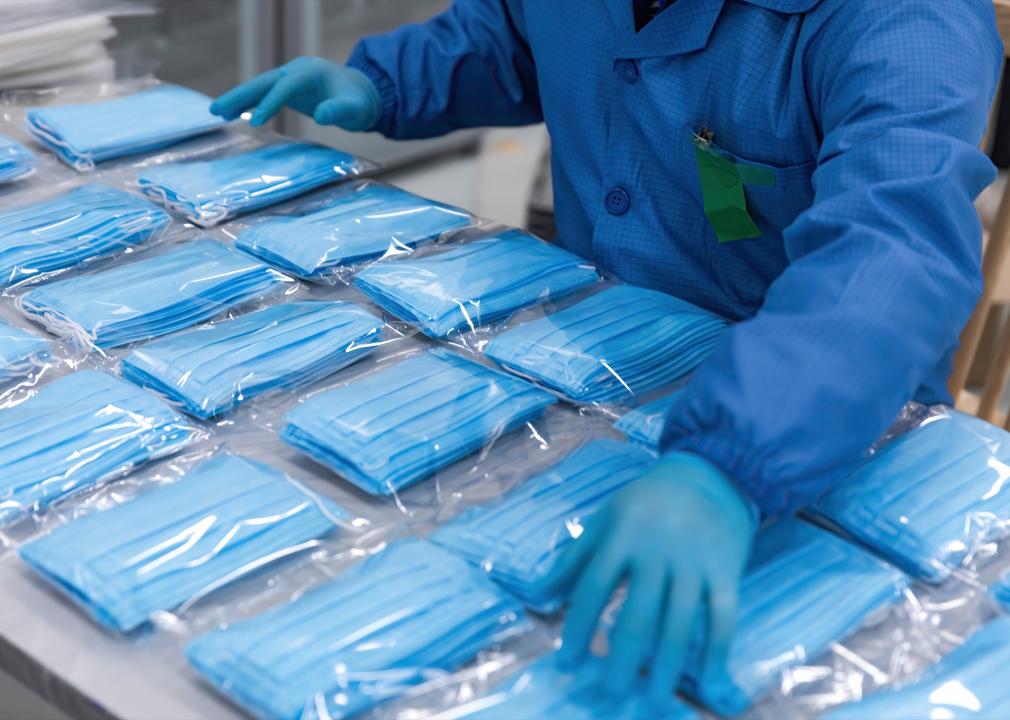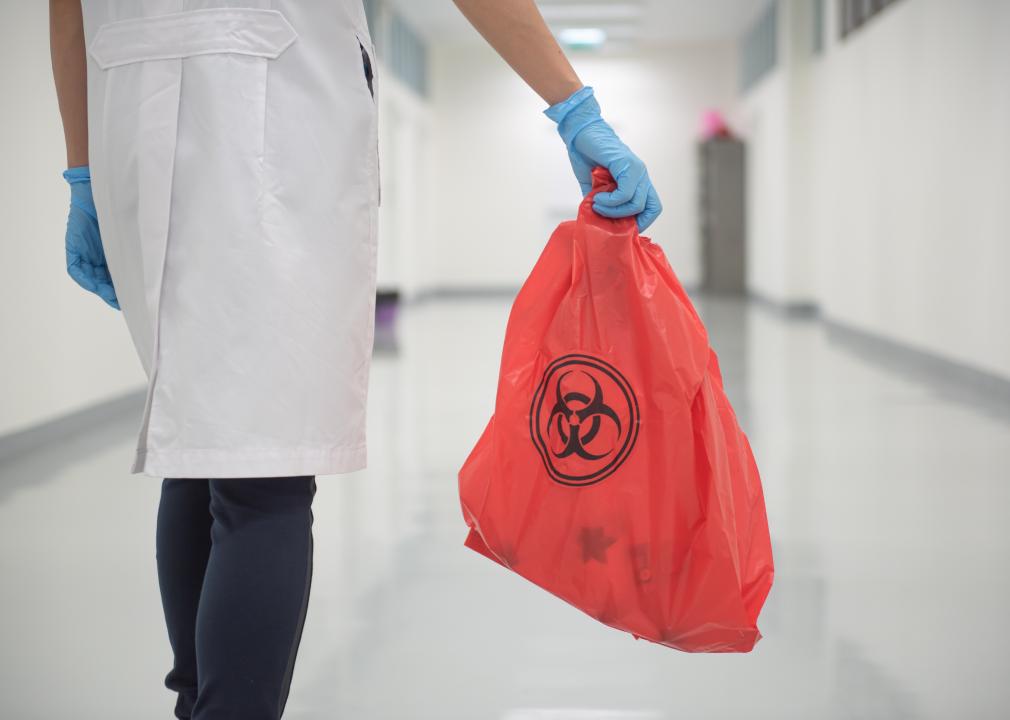Single-use plastics revolutionized the medical industry. Now, they're raising concerns about sustainability.

EleniyaChe // Shutterstock
Single-use plastics revolutionized the medical industry. Now, they’re raising concerns about sustainability.
Medical syringes and ampoules of plastic waste.
The 20th century brought airplanes, radio, television, the internet, and plastic. Lots of plastic.
That plastic is now showing up on shorelines, forming islands in oceans, and generating mountains of translucent trash on land. Around 700 species of animals in the sea have been found to interact with plastic daily.
Companies across every industry face pressure to reduce the amount of plastic they produce. Seventy-two percent of the world’s largest have made voluntary commitments to reduce their plastic waste, according to a Duke University analysis.
One industry, in particular, has greatly benefited from advancements in single-use plastic technology: the medical industry. Only in recent years have businesses and academics in the field begun to talk about minimizing their impact on our environment like beverage manufacturers and other consumer goods-producing businesses.
Medical Technology Schools analyzed academic studies published in the National Library of Medicine, the American Medical Association, and news reports to shed light on the medical community’s use of plastics through history, their environmental problems, and proposed solutions to reduce their impact.
And the impact can be significant. A single hospital patient generates nearly 34 pounds of waste a day—as much as a quarter of it is plastic.
The COVID-19 pandemic only worsened the problem.
![]()
LookerStudio // Shutterstock
Plastic medical waste booms during COVID-19
Doctor with gloves using a syring on a vial.
The pandemic pushed hospital capacity to the brink and led to a massive increase in personal protective equipment and medical supply usage. Medical-grade masks and other protective equipment like face shields, made mostly of nonrenewable plastics, were in high demand.
In 2020, the World Health Organization estimated that the international need for PPE manufacturing would boost 40% to address the public health crisis. Hospitals needed an estimated 89 million masks, 76 million gloves, and 1.6 million goggles every month of the pandemic. To date, nearly 677 million COVID-19 vaccine doses have been administered, each requiring their own plastic syringe, according to data from the Centers for Disease Control and Prevention.
Global consulting firm Frost & Sullivan estimated that the U.S. would produce a year’s worth of medical waste in just two months due to the pandemic. The World Economic Forum warned that the COVID-19 crisis threatened to “stall and even reverse progress” to reduce large plastic waste. It’s a challenge researchers acknowledge today as they search for solutions.
InkheartX // Shutterstock
Convenience gives way to cleanliness
Production of medical face masks.
Plastics introduced an era of ultraconvenience to the world. It makes our clothes. It’s made bike helmets and airbags possible. And it’s a cheap material to produce, meaning it’s cheap for consumers too. Almost as importantly, it’s durable and incredibly easy to make into complex shapes—a trait that helped plastics invented in the mid-20th century quickly replace more expensive metal and wooden goods.
That adoption extended to the medical field, where the single-use nature of plastics represented a move toward more hygienic tools for physicians and hospitals.
But it wasn’t plastic’s sanitary qualities that the industry first latched onto. Like so many other technical advancements, convenience and cost were the initial driving factors. That they were more conducive to creating a sterile environment for patients was a benefit that health care began to tout closer to the end of the 20th century.
PVC, or polyvinyl chloride, replaced glass bottles previously used to hold IV solution and replaced rubber tubing used throughout hospital settings. Plastic has also become the go-to material for making syringes and catheters.
Plastic products are generally made from chemicals derived from the oil and natural gas refining process. Chemists use those byproducts to create synthetic materials with malleable and durable chemical structures.
The low cost of these materials has helped medical device-makers support better health outcomes for communities across the U.S. since the 1900s. No longer was health care priced at rates only the elite could afford—it was accessible to a much larger swath of the public.
In the last decade, the U.S., in particular, has emerged as a massive market for medical plastics. The country generally accounts for nearly half of the global market for medical devices.
Plastic’s durability is not only a benefit but a detriment to the environment, as the material can take many years to deteriorate when it enters landfills or trashes oceans.
Estimates vary widely, but scientists ballpark that depending on the kind of plastic and the environment in which it decomposes, it could take dozens to thousands of years to break down entirely.

sirtravelalot // Shutterstock
Waste could pile higher, faster in the coming years
Close-up of hands attaching intravenous tube to patient’s hand in hospital bed.
COVID-19, which remains a burden for health care systems, isn’t the only force raising the stakes for a health care industry pressured to reduce reliance on plastics or find ways to reuse them.
Global annual production of plastic has doubled in the last two decades, according to the Environmental Protection Agency. As the U.S. looks toward the future, its aging population is another factor that could exacerbate the rate at which medical plastics end up in landfills.
People require more medical care as they age, and aging baby boomers are expected to place increased demand on the medical device industry. At the same time, governments are under pressure to lower health care costs, which have become unaffordable even for those insured.
Watchara Chuenchomnoi // Shutterstock
Organizations work to implement environmentally conscious plastic waste management
A woman holding a red bag with biohazard sign in the hospital.
As recently as 2021, researchers lamented a lack of data on efforts to recycle medical plastics.
Around 350 hospitals participate in Practice Greenhealth’s Environmental Excellence Awards. Practice Greenhealth is an organization working to help hospitals increase their sustainability. It’s one of the few sources of hospital sustainability data, and its roster of participating hospitals represents a small fraction of the more than 6,000 hospitals operating in the U.S.
To meet the need to reduce plastic waste generation, some hospitals are moving away from using plastic in certain applications. Ronald Reagan UCLA Medical Center replaced health care workers’ disposable plastic isolation gowns with reusable cloth gowns at its hospitals in the last decade, saving money and preventing literal tons of medical waste. It also implemented a process for sterilizing and incinerating the boxes that hold used needles, allowing them to be reassembled and reused in a health care setting.
Recycling plastic medical waste is complicated by the potential for contamination and the need to separate contaminated and noncontaminated waste; once separated, they can be broken down with heat or treated with chemicals and reprocessed. However, using chemical methods to break down and dispose of plastics has drawbacks. Over 200 nongovernmental organizations signed a letter in 2023 urging the Biden administration to end federal support for methods like these, arguing they generate toxic pollutants.
The Vinyl Council of Australia is working with hospitals to recover used materials made of PVC. The materials are broken down into tiny pieces, washed and heated at high temperatures, and remade into things used outside medical settings.
In the U.S. and Europe, there’s the Healthcare Plastics Recycling Council, a coalition of companies working in the health care device space that includes DuPont, Johnson & Johnson, and Medtronic. In 2021, the HPRC, advised by professionals at Kaiser Permanente and other health systems, rolled out a medical waste recycling pilot project with hopes of scaling it across more hospitals.
Story editing by Ashleigh Graf. Copy editing by Paris Close. Photo selection by Clarese Moller.
This story originally appeared on Medical Technology Schools and was produced and
distributed in partnership with Stacker Studio.








